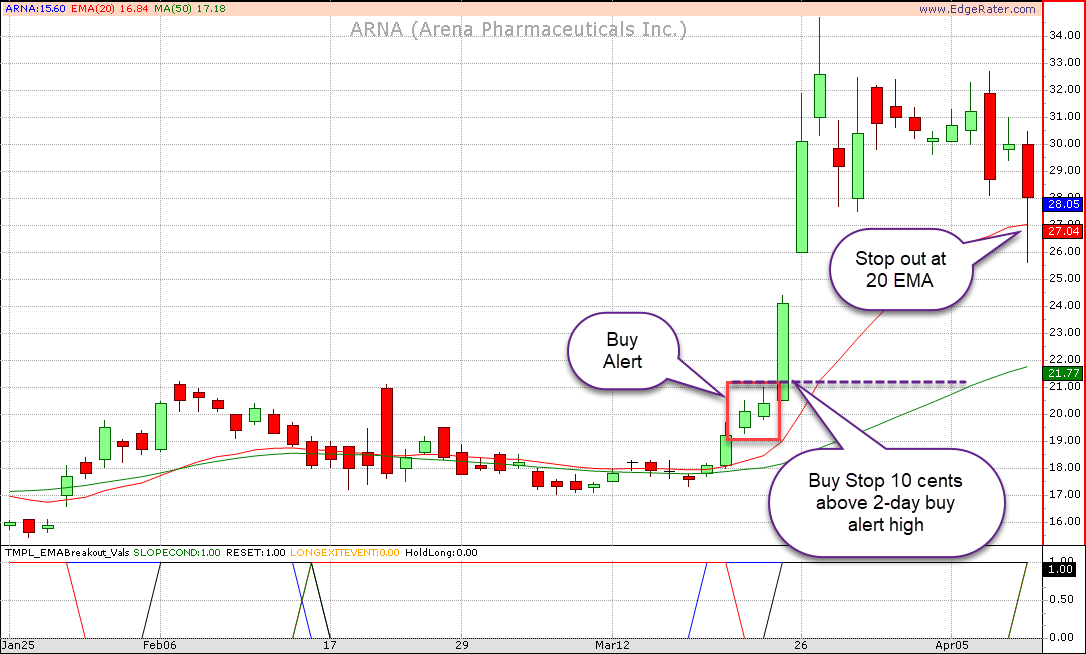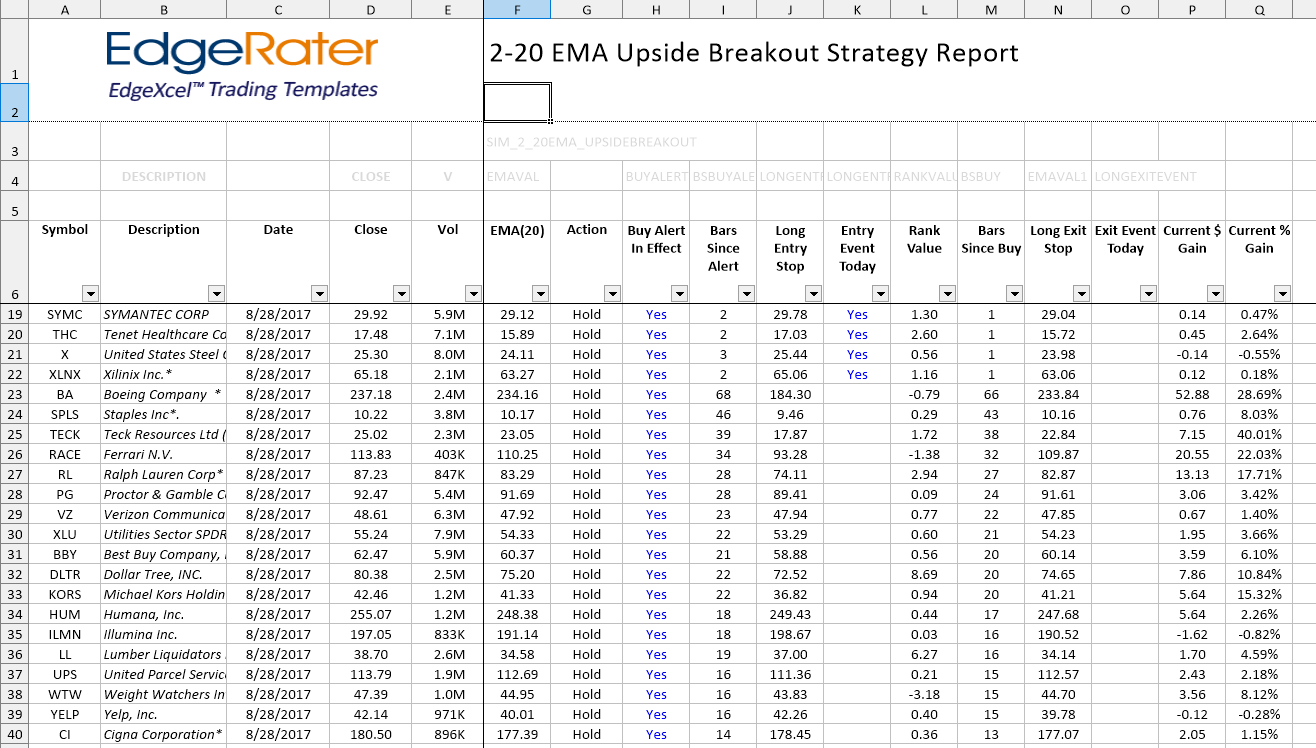In the December 1996 issue of Technical Analysis of Stocks and Commodities, David Landry presented the 2/20 EMA breakout trading system for capturing meaningful trends. The system has defined entry and exit rules that are based purely on the 20 EMA. The upside breakout entry rules require price to have a particular 2 day pattern above the EMA and the exit rules require a 1 day price touch of the EMA.
Please read the referenced article for all the details:
Article References
Landry, David S. “The 2/20 Day EMA Breakout System”, Technical Analysis of Stocks and Commodities Dec. 1996 V.14:12 (526-529)
How to find the Articles
If you have a subscription to S&C magazine you can find the articles online in the complete digital archive at traders.com
You can subscribe to the magazine (which includes access to the complete digital archive and over 30 years of articles) with the following link:

http://store.traders.com/cgi-bin/clink?traderscom+6HTKx9+index.html+
You can read just the individual article:

http://store.traders.com/cgi-bin/clink?traderscom+6HTKx9+-v14-c12-the220d-pdf.html
The Upside Breakout System in EdgeRater
In this post, I will explain the upside breakout system and how you can use the new EdgeRater template to follow the system with both entry signals and exit signals. The original article was based on trading commodities but the technical signals produced can be applied to stocks also.
The 2/20 EMA breakout system makes most money when a long trend develops in a stock after the breakout. The system falls into the category of trend trading and one characteristic of this type of systems is that there are more losing trades than winning ones but you are trying to capture the big gains that develop in some of the stocks and cut the losing positions quickly.
The System:
The system is called the 2/20 EMA breakout system because it requires two bars to be completely above the 20 EMA before a buy alert is triggered.
Buy Alert
A buy alert is triggered if the most recent 2 bars are completely above the 20-day EMA. This alert remains in effect until a bar touches or falls below the 20 EMA.
Example

Long Entry
Place a Buy Stop 10 cents above the buy alert 2-day high. Note original article is based on commodities and suggests a buy stop 10 ticks above the buy alert 2-day high.
Example

Long Exit
Stop out at the 20-day EMA. Note that the 20-day EMA is not fixed until the close of the day and so I have used the prior bar’s 20-day EMA as a stop. This allows stops to be placed at a known level going into a trading day.
Example

The 2-20 EMA Upside Breakout Template in EdgeRater
The 2-20 EMA Upside Breakout template can be found in the Stocks and Commodities category in EdgeRater and produces the following report when run:

Column Descriptions
Columns A through E are consistent with other templates in EdgeRater and contain stock information.
Columns F through Q contain data specific for this trading system. Here is a description of the columns:
EMA(20)
This is the current value of the 20-day EMA
Action
- Hold is shown if a trade is currently in play,
- Buy Alert is shown if there is a current Buy Alert as defined by the trading system rules.
- Blank is shown for all other cases.
Buy Alert
This is the ‘Raw’ buy-alert signal as output by the strategy script. It shows ‘Yes’ if there is currently a buy-alert regardless of whether a trade has already been taken for that stock. It is best to ignore this field and use the ‘Action’ field instead.
Bars Since Alert
Shows the number of bars that have passed since the most recent buy alert. Displays 0 if there is no alert.
Long Entry Stop
This is the price 10 cents higher than the high of the 2-day buy alert pattern and serves as a Long Entry Stop for subsequent trading days. Note this is only valid if the current Action is ‘Buy Alert’. If trading this system you would check the report in the evening after the market has closed and then for any stocks that have ‘Action = Buy Alert’ you could place an entry stop order for the following day at the Long Entry Stop price.
Entry Event Today
- Yes if the long entry stop price was hit during the day on a ‘buy alert’ stock
- Blank no entry event occurred today
Rank Value
Sometimes you have so many entry signals firing on one day and you need to pick just one or two to trade. This Rank Value is a good way to do that. Just choose the stocks with the highest value. In the backtesting trade simulator you can mimic this behavior by choosing a ‘Top N’ Rank selector on your entry signals.
Bars Since Buy
Shows the number of bars since the entry event occurred. If the Entry Event Today field is ‘Yes’ Bars Since Buy will be 1. This number increments daily until an exit event has been seen. Stocks with the highest number of Bars Since Buy generally have a higher % gain as they have been trending for a longer period of time without being stopped out.
Long Exit Stop
Indicates the protective stop price to exit the trade. Note this is only valid if the current Action is ‘Hold’.
Exit Event Today
- Yes if the long exit stop price was hit during the day on a ‘Hold’ stock
- Blank no exit event occurred today
Current $ Gain
Shows the $ Gain/loss for trades that are currently in the ‘Hold’ action state. Blank if trade is not currently in ‘Hold’
Current % Gain
Shows the % Gain/loss for trades that are currently in the ‘Hold’ action state. Blank if trade is not currently in ‘Hold’
Summary
David Landry’s 2/20 EMA trading system is a trend trading system with well-defined entries and exits based on the 20 period daily EMA. EdgeRater’s new Template ‘2/20 EMA Upside Breakout Strategy’ implements the upside breakout half of the trading system with Long entries only. The template can be run on any list of stocks and quickly identifies all existing stocks that are in a ‘Hold’ and all entries and exits that are firing today. Exact stop entry and stop exit prices are listed allowing you to enter orders for the following day into your trading platform. The template can be found in the ‘Stocks and Commodities’ category of your template library.
